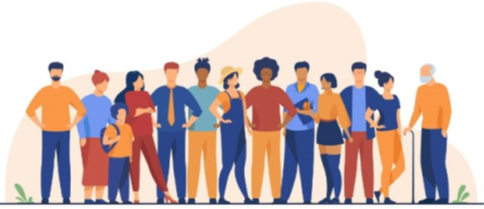The ageing of the world’s population, and the consequent postponement of retirement in many jurisdictions, has increased the likelihood of younger and older workers interacting at work. Up to four generations may coexist in contemporary organizations, with Portugal notably facing one of the most pronounced aging populations in Europe. In the context of an aging global population and shifting workforce demographics, understanding intergenerational relations in the workplace has never been more critical.
The recent study, Understanding Ageism in the Workplace, by David Patient, Susana Schmitz, Christin-Melanie Vauclair, Miriam Rosa, and Sofia Esteves sheds light on this pressing issue. The project, Bidirectional Ageism and Fairness Perceptions in the Workplace, coordinated by CUBE and funded by Fundação Francisco Manuel dos Santos, explores how age-related biases impact intergenerational relations within organizations. They underscore the need for targeted policies and interventions to foster inclusion and mitigate age-related tensions, thereby enhancing workplace equity and productivity.

An aging society and workforce present both challenges and opportunities. On one hand, the strain on social security and pension systems has prompted many OECD countries to revise early retirement policies and encourage greater labor participation among older workers. On the other hand, an aging population can drive economic growth and job creation, particularly in industries catering to the needs of seniors—often referred to as the "silver economy." Moreover, the presence of multiple generations in the workplace facilitates the transfer of knowledge, skills, and experience between age groups, enhancing organizational resilience. However, the coexistence of multiple generations can also lead to age-related tensions, with some workers perceived as 'too young' and others as 'too old.' These perceptions can significantly impact workplace relationships, attitudes, and performance, as well as the overall wellbeing of employees.
THE CONCEPT AND THE CHALLENGES OF AGEISM
Age, like gender and ethnicity, is a visible social category tied to physical traits. Although aging is a natural process, what it means to be "young" or "old" is shaped by cultural and societal norms. Ageism, defined as stereotypes, prejudice, or discrimination based on age, can be both positive and negative and can impact both younger and older people, influencing attitudes and behaviors in subtle or obvious ways.
Even though age discrimination is illegal in Europe and Portugal, ageism continues to be a major challenge as society adapts to an aging population. Age discrimination is more widespread than sexism or racial discrimination, particularly in the workplace, where ageist assumptions can affect how competence is judged. This can lead to unfair HR practices that disadvantage younger or older workers, creating a sense of unfairness that harms both employees and organizations.
In their research study, Patient and colleagues examined the predictors and consequences of ageism directed at both younger and older workers. Using a combination of qualitative and quantitative methods, including data from a representative sample of 1,000 Portuguese workers, they explored how stereotypes shape workplace expectations and the real-world consequences for those involved.
AGE-BASED STEREOTYPES IN ACTION
- Humility-Deference: Younger workers are expected to accept hierarchy and acknowledge their lower status.
- Loyalty-Belonging: They are expected to demonstrate loyalty and assimilate into their organizations.
- Vitality-Innovation: They are expected to bring energy, innovation, and technological skills to the workplace.
- For older workers in Portugal, younger individuals often held more negative stereotypes, particularly in private enterprises, where there was a stronger belief that older workers should step aside for younger employees. These stereotypes were less common in flexible, modern organizations in regions such as Lisbon Metropolitan Area and South regions, and more prevalent in traditional companies compared to public administration. Endorsing ageism against older workers was linked to poorer mental health and a greater intention to leave the job.
- For younger workers, ageist views were more likely to come from older, less educated individuals with conservative views. Interestingly, endorsing the Loyalty-Belonging and Vitality-Innovation stereotypes was associated with positive outcomes like better mental and physical health, higher job performance, and improved workplace attitudes.
- The downside: The Humility-Deference stereotype led to more negative consequences. Workers who expected younger colleagues to accept a lower status were more likely to support punitive actions when younger employees didn’t conform.
THE EFFECTS OF AGEISM ON WORKERS
The research revealed that ageism has mostly negative effects on those who experience it:
- Younger workers reported the highest levels of age discrimination, especially those with lower incomes or working in traditional organizations. These workers experienced reduced job satisfaction, lower performance, and higher intentions to leave their job, and greater perceived workplace conflict.
- Older workers who felt they were being pushed to step aside for younger colleagues showed lower organizational commitment, less engagement, reduced performance, and higher absenteeism.
- The Humility-Deference stereotype consistently led to negative outcomes, including feelings of unfairness, lower commitment, and a stronger urge to leave the company.
- On the other hand, the Loyalty-Belonging and Vitality-Innovation stereotypes had mixed effects—causing stress and decreased mental health but also boosting self-efficacy and improving self-reported performance, better interactions with colleagues, higher job satisfaction and stronger commitment to stay with the company, and better overall mental and physical health.
ORGANIZATIONS: HOW TO ADDRESS AGEISM FOR A MORE PRODUCTIVE WORKPLACE
Organizations must recognize the detrimental impact of age discrimination and stereotypes on employee satisfaction and retention. This suggests that interventions should be tailored to each age group's unique challenges.
- Promote Positive Age Beliefs: Holding positive attitudes toward older workers is linked to higher job satisfaction, highlighting the benefits of age-inclusive interventions for employee morale and organizational success.
- Reevaluate Stereotypes About Younger Workers: While certain prescriptive stereotypes about younger workers, such as Loyalty-Belonging and Vitality-Innovation, may improve job satisfaction and voluntary behaviors, they can also create undue pressure.
- Stereotypes that promote Humility-Deference are associated with negative outcomes, including higher exit intentions and lower commitment. Organizations should be cautious about fostering stereotypes, even those seemingly positive, as they can lead to bias and unfair treatment.
- Implement Diversity Training: To address the complexity of age-related stereotypes, organizations should invest in diversity training and action plans. This training should raise awareness of how stereotypes affect workers and emphasize the individuality and diversity within age groups, thereby reducing bias and fostering more equitable judgments. Companies can also use the WAYS tool to assess existing stereotypes, guide internal training, and promote discussions that lead to a more inclusive workplace.
- Enhance Intergenerational Contact: Simply having an age-diverse workforce is insufficient to break down ageist beliefs. Organizations should focus on creating high-quality intergenerational interactions, such as cross-generational team-building activities, to improve relations between younger and older workers.
- Foster a Positive Organizational Environment: Research shows that a positive work environment helps mitigate conflicts and reduce ageist attitudes, particularly toward older workers.

- Enact Anti-Ageism Laws: Implement policies that protect all age groups, which not only reduces ageism but also other forms of discrimination like racism and sexism.
- Support Intergenerational Initiatives: Programs fostering interaction between age groups, such as Portugal’s intergenerational imAGES program, effectively reduce ageist attitudes.
- Use Media to Raise Awareness: Campaigns through traditional and new media platforms can challenge age-related stereotypes and change societal perceptions.
- Collaborate with Researchers: Strengthen partnerships with researchers for evidence-based policymaking and widely disseminate knowledge on ageism.
- Address Bidirectional Ageism: Policies must recognize that ageism impacts both the young and old to avoid fueling intergenerational tensions.
In conclusion, tackling ageism is essential for creating inclusive workplaces where all employees can contribute fully. Reducing age-based discrimination improves societal well-being and organizational effectiveness, leading to higher job satisfaction, better retention, and improved performance across all age groups.